Ford Transit Connect
| Ford Transit Connect | |
|---|---|
 Ford Transit Connect | |
| Overview | |
| Manufacturer | Ford Europe Azure Dynamics (Ford Transit Connect Electric) |
| Also called | Ford Tourneo Connect Ford Transit Connect Electric |
| Production | 2002–present |
| Body and chassis | |
| Class | Leisure activity vehicle Compact panel van |
| Body style |
|
| Layout | Front-engine, front-wheel-drive |
| Chronology | |
| Predecessor |
|
The Ford Transit Connect is a compact panel van developed by Ford Europe. It is built on a dedicated commercial vehicle platform and shares parts with the Ford Focus. The first generation was designed by Peter Horbury and introduced in 2002 to replace the older Ford Escort and Fiesta-based Courier van ranges, which had ceased production in the same year. It has been imported to the North American market since the 2010 model year. In North America, the Transit Connect does not have a direct predecessor; the closest vehicle to its size was the standard-length Ford Aerostar cargo van, which ceased production in 1997.
The Ford Tourneo Connect, a leisure activity vehicle, is a Transit Connect with side windows and rear seats. All Transit Connects bound for the United States are imported in this configuration to avoid the 25% "chicken tax" on imported light trucks.[1] In 2013, US Customs told Ford that they must stop this practice of importing vans disguised as passenger cars.[2]
First generation (2002–2013)[]
| First generation | |
|---|---|
 Ford Transit Connect XLT Van (USA, post-facelift) | |
| Overview | |
| Also called | Ford Tourneo Connect Azure Transit Connect Electric |
| Production | 2002–2013 |
| Assembly | Kocaeli, Turkey (Ford Otosan) Craiova, Romania (Ford Romania) 2.0L engine: Valencia, Spain (Ford Valencia) |
| Body and chassis | |
| Body style | 4-/5-door panel van 5-door LAV |
| Platform | Ford C170 platform |
| Related | Ford Focus |
| Powertrain | |
| Engine | 1.8L Duratorq TDCi Diesel I4 1.8 Endura-D TDDi Diesel I4 2.0L Duratec Gasoline I4 |
| Transmission | 4-speed 4F27E automatic 5-speed manual |
| Dimensions | |
| Wheelbase | SWB: 2,664 mm (104.9 in) LWB: 2,912 mm (114.6 in) |
| Length | 2004–06 SWB: 4,278 mm (168.4 in) LWB: 4,555 mm (179.3 in) 2007–09 SWB: 4,308 mm (169.6 in) 2010– LWB: 4,590 mm (180.7 in) 2010– SWB: 4,275 mm (168.3 in) |
| Width | 1,795 mm (70.7 in) |
| Height | Pre–2009 SWB: 1,814 mm (71.4 in) LWB: 1,981 mm (78.0 in) 2010– LWB: 2,014 mm (79.3 in) 2010– SWB: 1,815 mm (71.5 in) |
| Curb weight | XL with 2.0L: 3,373 lb (1,530 kg) [3] XLT Wagon with 2.0L: 3,503 lb (1,589 kg) XLT Wagon (Premium) with 2.0L: 3,524 lb (1,598 kg) |
The Transit Connect was introduced in Europe in October 2002 as the replacement for car-derived vans based on the Escort and the Fiesta but as it is built on a dedicated commercial vehicle platform it is not a car-derived van itself. Production of the Escort in Europe ceased in 2000 (although the vans carried on for another two years), whilst the Fiesta Courier was also planned to be discontinued when the fifth generation Fiesta entered production in 2002. Ford elected not to develop a direct sedan delivery version of the Focus, instead pursuing a purpose built design.
Sharing few components with the much larger Transit, the Transit Connect was built on a dedicated commercial vehicle platform similar to the international Ford Focus, then common with the first generation North American Ford Focus.[4] Rather than adapting an existing bodystyle into a van, the Transit Connect was designed with sliding side doors.
The Escort van and the Fiesta Courier had been assembled at the Halewood and Dagenham plants in England, respectively, but both plants were to cease Ford car production (Halewood was to be handed over to Jaguar, whilst Dagenham was to become an engine plant only), so a new production facility was needed.
The Transit Connect was assembled by Otosan in an all-new production facility at Gölcük, near Kocaeli, Turkey.
In its first year on the North American market, the Transit Connect was awarded "North American Truck of the Year 2010" at the North American International Auto Show (NAIAS).[5]
2009 update[]
Since mid-2009, the Transit Connect has been imported to the United States and Canada. First shown in the United States at the 2008 Chicago Auto Show, the 2010 production model was introduced at the following year's show on 11 February 2009.[6]
The introduction of the North American variant coincided with a mid-cycle facelift which includes a restyled front grille, a deeper front bumper and a new dashboard featuring the switchgear and instrument pod from the C307 Focus.
Initially, only the long-wheelbase version of the van,[7] outfitted with a 2.0L four-cylinder petrol engine and 4 speed 4F27E, was offered in North America; elsewhere, the 1.8L diesel engine and 5 speed manual transmission was the only available powertrain. The 2.0L Duratec DOHC I-4 gasoline engine has 136 hp @6300rpm, and 128 lb.-ft. of torque @4750 rpm. It specifies minimum 87 octane gasoline and fuel economy is 21 mpg city/27 mpg hwy and 23 mpg combined.
An electric version followed in 2011, converted by Azure Dynamics Corporation at a U.S. facility.[8]
To build interest and awareness in North America, Transit Connects specifically equipped as "mobile showrooms" were displayed at industrial parks and other venues in 13 U.S. urban areas in May 2009, with the goal of offering 3,000 test drives to small business owners.[9]
With model year 2011, Ford offered the Transit Connect XLT Premium Wagon in the US and Canada, a passenger version of the van — with seating for five, rear windows that opened for ventilation, blind spot awareness, rear view camera, larger alloy wheels, body-colour grille, and front fog lamps.
The Transit Connect Wagon was the first Ford minivan since the 2007 discontinuation of the Freestar, though it was closer in size to the standard length Ford Aerostar sold from 1986 to 1997.

Ford Transit Connect (pre-facelift)

Ford Transit Connect rear (pre-facelift)
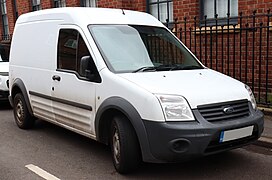
Ford Transit Connect (post-facelift)

Post-facelift model rear
Trim levels[]
In the U.S., the Transit Connect was available in two different trim levels:
XL: Manual windows, manual door locks, cloth seating surfaces, A/M-F/M stereo, two speakers, black-painted steel wheels w/ plastic wheel covers, 2.0L I4 engine, automatic transmission, front-wheel-drive, and air conditioning.
XLT: Power windows, power door locks, four speakers, and exterior-colored accents and bumpers.
For Passenger models, an XLT Premium model was offered, adding these features to the XLT: A/M-F/M stereo with single-disc CD/MP3 player and USB and auxiliary audio input jacks, leather seating surfaces, rear cargo door trim, and enhanced interior sound deadening material. This model appealed very much to families.
Second generation (2012–present)[]
| Second generation | |
|---|---|
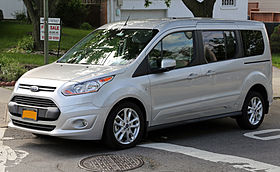 | |
| Overview | |
| Production | 2012–present |
| Model years | 2013–present (Europe and Turkey) 2014–present (North America) |
| Assembly | Almussafes, Valencia, Spain (Valencia Body & Assembly) |
| Designer | Paul Wraith[10] |
| Body and chassis | |
| Body style | 4-/5-door panel van 5-door LAV |
| Platform | Ford Global C-car Platform |
| Powertrain | |
| Engine |
|
| Transmission | 6-speed automatic 6F-35 6-speed manual B6 5-speed manual iB5 8-speed automatic 8F35 (2019-present) |
| Dimensions | |
| Wheelbase | |
| Length | |
| Width | 72.2 in (1,830 mm)[11] |
| Height | |
| Curb weight | |
The second generation Transit Connect was introduced on 6 September 2012 in Amsterdam, Netherlands. In its first redesign since its 2002 introduction, the 2014 Transit Connect adopts many features of the Kinetic Design language. A major design change is an optional rear liftgate in addition to the double doors preferred by commercial buyers and wheelchair users.[12] The Transit Connect will include the optional new feature called , a personalized key system. MyKey owner controls let the vehicle owner program different keys to restrict different vehicle features, such as top speed and maximum radio volume.[13]
Production now takes place at Valencia, Spain. As before, to avoid the 25% tariff on imported trucks, all cargo vans sold in the United States are built and shipped as passenger vans, which are then converted to cargo configuration before delivery.[14] Reports have been published that US Customs told Ford that they must stop this practice.[2]

North America[]
The 2014 Transit Connect is powered by a 2.5 L inline-4, or a 1.6 L EcoBoost turbocharged inline-4. The only transmission type available is the 6-speed 6F-35 automatic. For buyers interested in alternative-fuel vehicles, Ford offers optional hardware allowing for the 2.5L engine to be converted to use CNG or LPG/propane instead of gasoline.[15]
When sold in the United States, the Tourneo Connect bears the "Transit Connect Wagon" moniker, available in two wheelbases, and with a choice of 5 or 7-passenger seating. The latter configuration is the first 7-passenger minivan sold by Ford since the 2007 discontinuation of the Ford Freestar and Mercury Monterey.[16][17][needs update]
In 2014, it was available in three models:[citation needed]
XL: 2.5L I4 engine, 6-speed 6F-35 automatic transmission, front-wheel-drive, A/M-F/M stereo with auxiliary audio input jack, two speakers (four speakers for Passenger model), vinyl seating surfaces, manual windows, manual door locks, and sixteen-inch black-painted steel wheels w/ plastic wheel covers. The XL is actually slotted above the XLT in price on the Passenger model.
XLT adds: A/M-F/M stereo with HD Radio, USB and auxiliary audio input jacks and four speakers (Cargo model) or six speakers (Passenger model), Ford SYNC, power windows, and power door locks. The XLT is actually slotted below the XL in price on the Passenger model.
Titanium, for Passenger model only adds: A/M-F/M stereo with HD Radio, single-disc CD/MP3 player, rear backup camera, USB and auxiliary audio input jacks, leather seating surfaces, third-row seating, keyless entry and security system, increased interior sound deadening and interior panels, and sixteen-inch alloy wheels (upgradeable to seventeen-inch alloy wheels), as well as exterior-colored bumpers and exterior accents. This is the top-of-the-line Transit Connect model for the Passenger model, and is only available for the Passenger model.
2019 facelift[]
For the 2019 model year. the Transit Connect underwent a mid-cycle revision, receiving updates to the front fascia, with the interior receiving a redesigned dashboard.[18] Retaining the multiple wheelbases and body heights from its 2014 launch, the facelifted model replaces the 2.5L engine with a 2.0L direct-injection I4 (the 2.5L engine remains an option for LPG/CNG conversion).[18] At the launch of the model facelift, a 1.5L EcoBlue diesel engine was announced; both engines were paired with an 8-speed automatic transmission. In July 2019, after several delays, production of the diesel Transit Connect was abandoned for North America.[19]
For 2020 production, Ford ended production of the short-wheelbase Transit Connect passenger van, solely offering the three-row body style.[19]
Safety and recall[]
In 2017, Ford recalled 2013-2015 Ford Transit Connect with 1.6 ecoboost engines because of a risk of engine fires caused by a “lack of coolant circulation”. The recall partly contributed to a charge of US$300 million by Ford.[20][21]
Cargo capacities[]
- 105 cu. ft. (2.97 m³) of cargo space [24]
- 100+ cu ft. + Cargo volume behind first row (second-row seats folded)
- 50.0+ cu. ft Cargo volume behind second row
- 130 cu. ft. (3.68 m³) cargo [24]
- 19.8 cu ft Cargo volume behind third row, with seats slid forward
- 100+ cu ft. + Cargo volume behind first row (second-row seats folded)
Max speed and fuel usage[]
2.5 L 2014 Ford Transit Connect Cargo have est. MPG(City): 22 mpg‑imp (13 L/100 km), MPG(Highway): 34 mpg‑imp (8.3 L/100 km), 0–60 time: 9.5 sec. and top speed of 108 miles per hour (174 km/h).[25]

2014 Ford Transit Connect SWB

2014 Ford Transit Connect SWB, rear

Pre and post-facelift Ford Transit Connect (UK)

2019 Ford Transit Connect (facelift)

2019 Ford Transit Connect, rear (facelift)
Tariff circumvention[]
Ford imports all Transit Connects to the United States as passenger vehicles with rear windows, rear seats, and rear seat-belts to circumvent the 25% tariff on imported light trucks.[1] The vehicles are exported from Turkey on cargo ships owned by Wallenius Wilhelmsen Logistics, arrive in Baltimore, and are converted into commercial vehicles at WWL Vehicle Services Americas Inc. facility: rear windows are replaced with metal panels and rear seats removed (except on wagons).[1] The removed parts are recycled.[1]
The process exploited a perceived loophole in the customs definition of a commercial vehicle. As cargo does not need seats with seat belts or rear windows, presence of those items exempts the vehicle from commercial vehicle status. The conversion cost Ford hundreds of dollars per van but saved thousands over having to pay the tax.[1]
Partly because of this, only the long-wheelbase, high-roof configuration is exported to North America. In most places the high-roof Transit Connect, like most Ford Econoline vans, is unable to access multi-story parking because of its height of 1.98 m (6′ 6″).[26]
As of July 2018, Ford continues to employ the loophole but has been continuously in court over the practice.[27]
On June 7, 2019, the United States won its appeal in the Federal Appellate Court. The court determined that the Ford Transit Connect was a vehicle for the transportation of cargo.[28]
Since 2019 production, the conversion process of Transit Connects has undergone major revision. While all vehicles are still imported from Spain as passenger vehicles and converted to cargo vans (a process that happens to approximately 85% of Transit Connects imported to North America[18]), the conversion no longer involves the disposal/recycling of the removed parts; instead, the removed rear seats and rear windows are shipped to Ford in Spain for reuse.[18]
The next-generation Transit Connect, due for the 2022 model year, will be fully assembled for North America in Mexico at Hermosillo Stamping and Assembly.[citation needed] Like all future Ford products built in Mexico, it will comply with the 75% US/Canada/Mexico content rule of the new USMCA trade deal set to take effect in 2020.[citation needed]
Fleet usage[]
Grumman LLV replacement[]
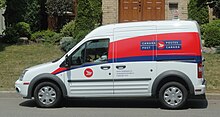
On 18 March 2010, Canada Post and Ford Motor Company announced that Canada Post would purchase a fleet of Ford Transit Connect vans to replace their aging fleet of Grumman LLV vehicles.[29] Right-hand-drive tooling already existed for the versions sold in RHD markets, but all Canada Post Transit Connects are left-hand drive.
Taxicab[]

In fleet (taxi) applications, Ford markets the Ford Transit Connect Wagon as a replacement for the Ford Crown Victoria LWB (discontinued in 2011). For taxi use, modifications include shifting the rear seat several inches rearward (to increase legroom and to allow for the fitment of a partition), rear-seat climate controls, and school bus yellow paint.[30]
By 2011, the Transit Connect was one of three finalists (alongside the Karsan V-1 and the Nissan NV200) in the New York City Taxi of Tomorrow bid, in a potential 10-year contract to supply the city with taxicabs exclusively.[31] While losing the Taxi of Tomorrow bid to the Nissan NV200, the Transit Connect Wagon remains in use as a taxicab replacement for the Crown Victoria in New York City (as an accessible cab) and other American municipalities, as well as Hong Kong.
Variants[]
Transit Connect Electric[]

At the 2009 Chicago Auto Show, Ford confirmed development of a battery-powered version of the Transit Connect.[32] Later at the Geneva Auto Show the same year, Ford showed a prototype electric version of the Ford Tourneo Connect passenger van, which is closely related to the Ford Transit Connect. Ford originally announced Smith Electric Vehicles would install the electric drivetrains and lithium-ion battery packs in the vehicles,[33] but they later partnered with Azure Dynamics Corporation instead,[34] with Johnson Controls-Saft as the battery supplier.[35]
Production of the Transit Connect Electric began in December 2010,[36][37] and Azure Dynamics is the official manufacturer of record.[38] The official US Environmental Protection Agency range is 56 mi (90 km) and has a combined city/highway fuel economy rating of 62 miles per gallon gasoline equivalent (3.8 L/100 km equivalent) based on the five-cycle tests using varying driving conditions and climate controls.[39] The electric van costs US$57,400, which more than doubles the price of the gas-powered version even after federal and any state or local incentives for electric vehicles is discounted.[36][37]
Transit Connect X-Press[]
In 2004, Ford of Europe created the Ford Transit Connect X-Press, based upon a pre-production Transit Connect prototype and a 212 hp 2.0L engine of the Ford Focus RS.[40] Using a short-wheelbase cargo van with a rear liftgate, the X-Press is fitted with the front suspension, four-wheel disc brakes, and steering of the Focus RS.[41] The cargo bay is fitted with a full-body roll cage along with two spare tires.[40][41]
During 2006, the Transit Connect X-Press saw minor exterior changes to better reflect the production vehicle.[41]
Tourneo Connect[]
The Ford Tourneo Connect is a leisure activity vehicle produced by Ford, which was first put into production in 2002 to the British market. Much like the Tourneo is a passenger version of the Transit, the Tourneo Connect was designed with rear windows and seats. Principally termed a commercial vehicle, Ford predicted relatively low sales of between 800–1000 mainly to taxi operators, due to its given status as a commercial vehicle. However, Ford described the Connect as a 'dual use' vehicle, equally able to meet business and leisure needs. It was put into production to rival the similar models of the Citroën Berlingo, Peugeot Partner, Volkswagen Caddy, Fiat Doblò and the Opel/Vauxhall Combo Tour.
The Connect, when first sold, was the only vehicle of its kind to offer folding and separately removable 60/40 split rear seats that allowed multiple seating formations and increased load capacity. It also boasted the option of twin sliding side load doors as well as rear doors or a tailgate, whereas neither of its main competitors have this option. The Connect's design emphasizes Ford's ideal that the vehicle be multipurpose.
First generation Tourneo Connect
First generation Tourneo Connect, rear
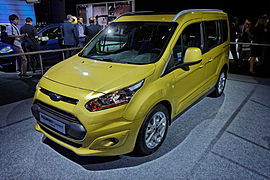
Ford Tourneo Connect, second generation

Ford Tourneo Connect, second generation (rear)
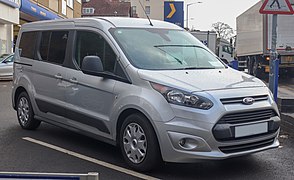
2015 Ford Grand Tourneo (LWB)
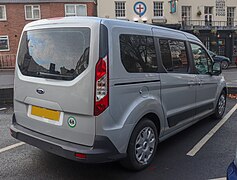
2015 Ford Grand Tourneo, rear (LWB)

Ford Tourneo Connect, facelift

Ford Tourneo Connect, facelift (rear)
Electric[]
Ford presented the Ford Tourneo Connect battery electric concept vehicle at the 2009 Geneva Motor Show. It features a 21 kWh lithium iron phosphate battery pack, a 50 kW permanent magnet motor, and a single-speed transmission, for a range of up to 160 kilometres (99 mi) and top speed of about 113 kilometres per hour (70 mph).[42] Its BEV technology was developed in collaboration with Smith Electric Vehicles.[43]
References[]
- ^ Jump up to: a b c d e Matthew Dolan (23 September 2009). "To Outfox the Chicken Tax, Ford Strips Its Own Vans". The Wall Street Journal.
- ^ Jump up to: a b "Is The 'Chicken Tax' On The Chopping Block? Trade Deals Could See More Small Pickups In US Market If Import Tariff Is Lifted". International Business Times. 29 June 2015. Retrieved 18 September 2021.
- ^ "Transit Connect Dimensions and Capacities" (PDF).
- ^ "Ford Imports Transit Connect from Europe". Nextautos.com, Evan McCausland. 2 June 2008.
- ^ "Detroit 2010: Ford sweeps North American Car and Truck of the Year awards for 2010". autoblog.com, Chris Paukert. 11 January 2010.
- ^ Michael Gauthier (9 February 2009). "Ford Launches all-new 2010 Transit Connect for U.S." World Car Fans.
- ^ Ford 2010 Transit Connect brochure, ref. # 10TCONCAT
- ^ "Archived copy". Archived from the original on 27 June 2013. Retrieved 13 April 2011.CS1 maint: archived copy as title (link)
- ^ "Archived copy". Archived from the original on 19 May 2009. Retrieved 19 May 2009.CS1 maint: archived copy as title (link)
- ^ "Vehicle exterior". Retrieved 16 September 2016.
- ^ Jump up to: a b c d e f g h i j "TRANSIT CONNECT Specifications". Ford Motor Company. Archived from the original on 28 February 2014. Retrieved 24 February 2014.
- ^ http://www.autoguide.com/auto-news/2012/12/2014-ford-transit-connect-a-people-focused-salvo-into-the-commercial-van-market.html
- ^ "Archived copy". Archived from the original on 4 December 2012. Retrieved 29 November 2012.CS1 maint: archived copy as title (link) MyKey® | 2014 Ford Transit Connect Wagon | Multi-Purpose For The Multi-You | Ford.com
- ^ "Car and Driver: Ford Transit Connect". Car and Driver. Retrieved 25 May 2015.
- ^ "2014 Transit Connect: CNG/LPG Gaseous Engine Prep Package". Ford Motor Company. Archived from the original on 16 October 2013. Retrieved 2 September 2013.
- ^ "Ford shows off 2014 Transit Connect Wagon, confirms cargo model for Detroit". Autoblog. Retrieved 18 September 2021.
- ^ "Archived copy". Archived from the original on 14 December 2012. Retrieved 17 December 2012.CS1 maint: archived copy as title (link)
- ^ Jump up to: a b c d "2019 Ford Transit Connect Cargo Van First Look". Motor Trend Canada. 7 March 2018. Retrieved 26 February 2019.
- ^ Jump up to: a b Capparella, Joey (9 July 2019). "Ford Cancels Plans for a Diesel-Powered Transit Connect Van in the U.S." Car and Driver. Retrieved 18 September 2021.
- ^ Lynch, Jim (29 March 2017). "Ford recalls 230,000 cars over potential engine fires". The Detroit News. Retrieved 1 April 2017.
- ^ Krisher, Tom (29 March 2017). "Ford recalls 570,000 vehicles for engine fire risk, door latch trouble". The Globe and Mail. AP. Retrieved 1 April 2017.
- ^ Jump up to: a b c Wojdyla, Ben (13 November 2012). "2014 Ford Transit Connect Wagon". Popular Mechanics. Retrieved 18 September 2021.
- ^ Jump up to: a b "Archived copy" (PDF). Archived from the original (PDF) on 12 June 2013. Retrieved 5 June 2013.CS1 maint: archived copy as title (link)
- ^ Jump up to: a b "StackPath". www.forconstructionpros.com. Retrieved 18 September 2021.
- ^ "2014 Ford Transit Connect Cargo @ Top Speed". Top Speed. 12 August 2013. Retrieved 18 September 2021.
- ^ "2014 Ford Transit Connect Wagon brings minivans back to the Blue Oval". 13 November 2012. Retrieved 19 November 2012.
- ^ "The strange case of Ford's attempt to avoid the 'chicken tax'". The Washington Post. 6 July 2018. Retrieved 18 September 2021.
- ^ http://www.cafc.uscourts.gov/sites/default/files/opinions-orders/18-1018.Opinion.6-7-2019.pdf
- ^ Ford Motor Company Press Release, "Canada Post Selects Ford Transit Connect to Replace Aging National Fleet of Light Vehicles," Archived 19 July 2010 at the Wayback Machine 18 March 2010.
- ^ "Archived copy". Archived from the original on 7 May 2013. Retrieved 22 November 2012.CS1 maint: archived copy as title (link)
- ^ Berk, Honey (5 December 2010). "Meet the Taxis of Tomorrow". AOL. Retrieved 26 January 2011.
- ^ Sam Abuelsamid (9 February 2009). "Ford confirms Transit Connect EV with Smith Electric for 2010". AutoblogGreen. Retrieved 27 September 2009.
- ^ "Ford Transit Connect to be assembled in Kansas City". Ford. 27 March 2009. Archived from the original on 13 August 2009. Retrieved 4 February 2017.CS1 maint: bot: original URL status unknown (link)
- ^ Josie Garthwaite (30 October 2009). "Why Ford & Smith Electric Have Called It Quits on Electric Van Partnership". Earth2Tech. Retrieved 30 October 2009.
- ^ "FORD AND AZURE DYNAMICS TEAM UP TO DELIVER BATTERY ELECTRIC COMMERCIAL VAN IN 2010" (Press release). Ford Motor Company. 29 October 2009. Archived from the original on 8 March 2010. Retrieved 4 February 2017.CS1 maint: bot: original URL status unknown (link)
- ^ Jump up to: a b Nick Bunkley (7 December 2010). "Ford Starts to Ship an Electric Delivery Van". The New York Times. Retrieved 10 December 2010.
- ^ Jump up to: a b "Ford and Azure Dynamics Mark Production and Delivery of First Transit Connect Electrics". Ford Motor Company Press Release. 7 December 2010. Archived from the original on 10 December 2010. Retrieved 4 February 2017.CS1 maint: bot: original URL status unknown (link)
- ^ Matthew Dolan (24 September 2010). "Ford Works with Manufacturer for New Electric Van". The Wall Street Journal. Retrieved 1 November 2011.
- ^ EPA. "2011–12 Electric Vehicles: Trucks". US Environmental Protection Agency. Retrieved 1 November 2011.
- ^ Jump up to: a b "Ford Transit Connect X-Press". Auto Express. Retrieved 18 September 2021.
- ^ Jump up to: a b c "Speedy Delivery: The Ford Transit Connect X-Press". Jalopnik. Retrieved 18 September 2021.
- ^ Sebastian Blanco (2 March 2009). "Geneva 2009: Ford's all-electric Tourneo Connect". AutoblogGreen. Retrieved 27 September 2009.
- ^ "FORD REVEALS NEW TOURNEO CONNECT WITH BATTERY ELECTRIC POWERTRAIN". Ford. 2 March 2009. Archived from the original on 26 May 2009. Retrieved 4 February 2017.CS1 maint: bot: original URL status unknown (link)
External links[]
| Wikimedia Commons has media related to Ford Transit Connect. |
| show |
|---|
| show |
|---|
- Ford of Europe vehicles
- Ford vehicles
- Mini MPVs
- Vans
- Vehicles introduced in 2002
- 2000s cars
- 2010s cars
- Production electric cars
- Cars of Turkey
- Taxi vehicles
- Cars of Spain
- Leisure activity vehicles
















